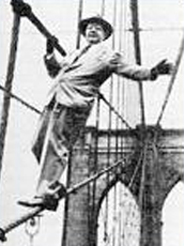 [Edit photo credit]
[Edit photo credit] 1886 – 1960
"A bridge is a poem stretched across a river, a symphony of stone and steel." For 40 years New York native David Barnard Steinman was the leading proponent of long-span suspension bridges, rivaled only by the Swiss-born Othmar Ammann (1879-1965). During his career Steinman and his associates were responsible for the design and construction of over 400 bridges, including the Henry Hudson Bridge in New York, the Mackinac Bridge in Michigan, the Deer Isle Bridge in Maine, and the St. Johns Bridge in Oregon.
David Barnard Steinman was born June 11, 1886 in the shadow of the Brooklyn Bridge. Little is known of his parents and six siblings other than the fact that Steinman failed to mention them later in his life. A mathematical prodigy, Steinman worked his way through City College, graduating summa cum laude in 1906. Immediately thereafter he attended Columbia University and completed three degrees culminating with a PhD in civil engineering. Steinman's thesis, entitled "The Design of the Henry Hudson Memorial Bridge as a Steel Arch," would become reality 25 years later.
Steinman accepted a teaching position at the University of Idaho, but soon longed for New York. He contacted Gustav Lindenthal about the possibility of working with him on the Hell's Gate Bridge. On July 1, 1914, Steinman became Lindenthal's special assistant, second only to another young bridge builder, Othmar Ammann. The experience of working together on the Hell's Gate project commenced a rivalry between Steinman and Ammann that lasted for the next 40 years. In 1920 Steinman met Holton Robinson, engineer of the Williamsburg Bridge, and the two formed a company that would design and construct hundreds of bridges until Robinson's death in 1945. Two early projects included the Florianopolis Bridge (1926), the largest span bridge in South America, and the Carquinez Strait Bridge (1927) 25 miles northeast of San Francisco, the second largest cantilever bridge in the United States. It was during this formative period with Robinson that Steinman, as president of the American Association of Engineers, began to campaign for more stringent educational and ethical standards within the engineering profession. His concern for professionalism continued when he founded the National Society of Professional Engineers in 1934 and served as the society's first President.
By the mid-1930s Steinman had established himself as one of the premier bridge builders of his generation, but his creations were eclipsed by Ammann's George Washington Bridge (1931) and Joseph Strauss's Golden Gate Bridge (1937). In response Steinman made plans to seize the span record by building the "Liberty Bridge " across New York Harbor. But with the collapse of the Tacoma Narrows Bridge (1940) the future of long-span suspension bridges appeared in jeopardy. The disaster prompted Steinman to publish a series of articles on the aerodynamic stability of bridge design. His theoretical aptitude led to the Mackinac Bridge project that would connect the Upper and Lower Peninsulas of Michigan — a project made all the more appealing because Steinman was selected ahead of Ammann.
Steinman's design innovations, such as open-grid roadways and stiffened trusses raised the theoretical critical wind velocity of the new design to 642 miles per hour. Though the Golden Gate retained the record for the longest suspended span between towers, the Mackinac Bridge was actually longer in total suspended span by almost 1000 feet. The Mackinac would remain Steinman's crowning achievement, since Ammann's political ties with Robert Moses granted him the prized Verrazano Bridge contract spanning New York Harbor. In response, Steinman prepared plans to cross the two-mile-wide Strait of Messina between Sicily and the Italian mainland, but the Messina Bridge remained on the drawing board with his death in 1960.

